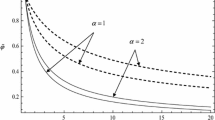Abstract
The flow formed in the neighborhood of the discontinuity intersection point when shock waves collide at a nonzero angle is studied. The investigation can be directly applied to problems of shock wave interaction in the interplanetary plasma [9–12]. In magnetohydrodynamics the nature of the flow and its investigation are much more complex than in gas dynamics because of the greater number of possible waves and governing parameters.
Similar content being viewed by others
Literature cited
G. G. Chernyi, Gas Dynamics [in Russian], Nauka, Moscow (1988).
L. D. Landau and E. M. Lifshitz, Hydrodynamics [in Russian], Nauka, Moscow (1986).
A. A. Barmin and E. A. Pushkar', “Steady-state interaction of strong discontinuities in magnetohydrodynamics,” in: Sixth All-Union Congress on Theoretical and Applied Mechanics, Tashkent, September 1986, Abstracts of Proceedings [in Russian], Tashkent (1986), p. 79.
A. A. Barmin and E. A. Pushkar', “Oblique interaction of strong discontinuities in magnetohydrodynamics,” in: Modern Problems in Mechanics [in Russian], Izd. MGU, Moscow (1987), p. 100.
A. A. Barmin and E. A. Pushkar', “Oblique interaction of Alfvén and contact discontinuities in magnetohydrodynamics,” Izv. Akad. Nauk SSSR, Mekh. Zhidk. Gaza, No. 1, 131 (1990).
M. Natter, “Shock reflexion and shock-wave interaction in field-aligned flows,” J. Plasma Phys.,14, 39 (1975).
A. R. Bestman, “Refraction of hydromagnetic shocks,” J. Plasma Phys.,18, 189 (1977).
A. R. Bestman, “Confluence of three shock waves for transverse shocks and shocks in an aligned MHD field,” J. Plasma Phys.,13, 107 (1975).
F. M. Neubauer, “Nonlinear oblique interaction of interplanetary tangential discontinuities with magnetogasdynamic shocks,” J. Geophys. Res.,80, 1213 (1975).
F. M. Neubauer, “Nonlinear interaction of discontinuities in the solar wind and the origin of slow shocks,” J. Geophys. Res.,81, 2248 (1976).
H. C. Zhuang, C. T. Russell, E. J. Smith, and J. T. Gosling, “Three-dimensional interaction of interplanetary shock waves with the bow shock and magnetopause: a comparison of theory with ISEE observations,” J. Geophys. Res.,A86, 5590 (1981).
S. A. Grib, E. A. Pushcar', and A. A. Barmin, “The interaction of the solar wind and discontinuities in the vicinity of heliopause,” Physics of the Outer Heliosphere/1-st COSPAR Colloquium Warsaw, Poland, September (1989), p. 73.
V. B. Baranov and K. V. Krasnobaev, Hydrodynamic Theory of Cosmic Plasma [in Russian], Nauka, Moscow (1977).
C. T. Russell, “Multipoint measurements of upstream waves,” Adv. Space Res.,8, 147 (1988).
E. A. Pushkar', A. A. Barmin, and S. A. Grib, “Investigation in the MHD approximation of the interaction of a solar wind shock wave with the bow shock,” Geomagn. Aeron.,31, No. 3 (1991).
Author information
Authors and Affiliations
Additional information
Translated from Izvestiya Akademii Nauk SSSR, Mekhanika Zhidkosti i Gaza, No. 3, pp. 132–143, May–June, 1991.
Rights and permissions
About this article
Cite this article
Barmin, A.A., Pushkar, E.A. Shock wave intersection in magnetohydrodynamics. Fluid Dyn 26, 428–437 (1991). https://doi.org/10.1007/BF01059016
Received:
Issue Date:
DOI: https://doi.org/10.1007/BF01059016




